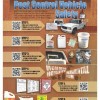 Do you need to train your employees about vehicle safety while transporting pesticides? This poster introduces safety concepts when transporting pesticides on a vehicle and alerts new pest control technicians to the pest control vehicle regulations of the Florida Department of Agriculture. The poster has quick response (QR) codes linked to short, online videos that take the technicians though six steps of maintaining a safe and legal service vehicle. This poster will serve as a valuable training and refresher tool. Designed by R.W. Baldwin, S.K. Hill, Philip Koehler, P.A. Mitola, and J.C. Medley, and published by the UF Department of Entomology and Nematology, August 2012.
Do you need to train your employees about vehicle safety while transporting pesticides? This poster introduces safety concepts when transporting pesticides on a vehicle and alerts new pest control technicians to the pest control vehicle regulations of the Florida Department of Agriculture. The poster has quick response (QR) codes linked to short, online videos that take the technicians though six steps of maintaining a safe and legal service vehicle. This poster will serve as a valuable training and refresher tool. Designed by R.W. Baldwin, S.K. Hill, Philip Koehler, P.A. Mitola, and J.C. Medley, and published by the UF Department of Entomology and Nematology, August 2012.
http://edis.ifas.ufl.edu/in963
Author: dihagan
Salmonella and Pathogenic E. coli in the Crop Production Environment: Potential Sources, Survival, and Management (SL375/SS576)
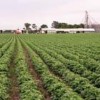 Over the last two decades, at least a dozen major outbreaks of gastroenteritis caused by non-typhoidal Salmonella or enterovirulent E. coli have been linked to the consumption of sprouts, nuts, and fresh (or minimally processed) fruits and vegetables. These outbreaks caught scientists and the public off guard because these pathogens were not previously considered “plant-associated.” This 3-page fact sheet highlights recent discoveries that focus on the ecology of human pathogens in the crop production environment. A better understanding of how pathogens persist outside of animal hosts in agricultural water, soils, and plants will have major impacts on managing produce safety from “farm to fork.” Written by Max Teplitski, Andree George, and George Hochmuth, and published by the UF Department of Soil and Water Science, October 2012.
Over the last two decades, at least a dozen major outbreaks of gastroenteritis caused by non-typhoidal Salmonella or enterovirulent E. coli have been linked to the consumption of sprouts, nuts, and fresh (or minimally processed) fruits and vegetables. These outbreaks caught scientists and the public off guard because these pathogens were not previously considered “plant-associated.” This 3-page fact sheet highlights recent discoveries that focus on the ecology of human pathogens in the crop production environment. A better understanding of how pathogens persist outside of animal hosts in agricultural water, soils, and plants will have major impacts on managing produce safety from “farm to fork.” Written by Max Teplitski, Andree George, and George Hochmuth, and published by the UF Department of Soil and Water Science, October 2012.
http://edis.ifas.ufl.edu/ss576
Pesticide Safety Miniposter: Triple Rinse Steps (ENY2012/IN962)
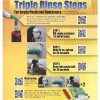 The Triple Rinse poster acquaints new pest management technicians to proper techniques to clean and dispose of empty pesticide containers. The poster uses quick response (QR) codes that direct smartphones to online videos that demonstrate the triple rinse process and container disposal. This poster will serve as a valuable training tool for new technicians and a refresher tool for pesticide applicators. Designed by R.W. Baldwin, S.K. Hill, Philip Koehler, W. Walker, and J.C. Medley, and published by the UF Department of Entomology and Nematology, 8. http://edis.ifas.ufl.edu/in962
The Triple Rinse poster acquaints new pest management technicians to proper techniques to clean and dispose of empty pesticide containers. The poster uses quick response (QR) codes that direct smartphones to online videos that demonstrate the triple rinse process and container disposal. This poster will serve as a valuable training tool for new technicians and a refresher tool for pesticide applicators. Designed by R.W. Baldwin, S.K. Hill, Philip Koehler, W. Walker, and J.C. Medley, and published by the UF Department of Entomology and Nematology, 8. http://edis.ifas.ufl.edu/in962
Pesticide Safety Miniposter: Pesticide Spill Control (ENY2011/IN961)
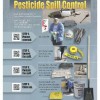 This poster acquaints new pest control technicians with proper procedures to manage an unscheduled pesticide release. The poster has quick response (QR) codes that direct a smartphone to online videos highlighting the steps of cleaning up a pesticide spill site, beginning with controlling the spill and ending with decontamination of the site. This poster will serve as a valuable training tool for new technicians and a refresher tool for pesticide applicators. Designed by R.W. Baldwin, S.K. Hill, Philip Koehler, P.A. Mitola, and J.C. Medley, and published by the UF Department of Entomology and Nematology, August 2012.
This poster acquaints new pest control technicians with proper procedures to manage an unscheduled pesticide release. The poster has quick response (QR) codes that direct a smartphone to online videos highlighting the steps of cleaning up a pesticide spill site, beginning with controlling the spill and ending with decontamination of the site. This poster will serve as a valuable training tool for new technicians and a refresher tool for pesticide applicators. Designed by R.W. Baldwin, S.K. Hill, Philip Koehler, P.A. Mitola, and J.C. Medley, and published by the UF Department of Entomology and Nematology, August 2012.
http://edis.ifas.ufl.edu/in961
Pesticide Safety Miniposter: Protecting Yourself (ENY2010/IN960)
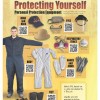 To properly apply pesticides, a technician must be aware of the personal protective equipment, or PPE, required for the application. This poster introduces new pest control technicians to different types of PPE they may be required to wear during a pesticide application or pest management inspection. There is a wide array of examples of PPE on the poster, with quick response (QR) codes that direct smartphones to short, online videos explaining PPE for each area of the body (head, eyes, face, mouth, hands and arms, torso and feet). This poster will serve as a valuable training tool for new technicians and a refresher tool for pest managers. Designed by R.W. Baldwin, S.K. Hill, Philip Koehler, W. Walker, and J.C. Medley, and published by the UF Department of Entomology and Nematology, August 2012.
To properly apply pesticides, a technician must be aware of the personal protective equipment, or PPE, required for the application. This poster introduces new pest control technicians to different types of PPE they may be required to wear during a pesticide application or pest management inspection. There is a wide array of examples of PPE on the poster, with quick response (QR) codes that direct smartphones to short, online videos explaining PPE for each area of the body (head, eyes, face, mouth, hands and arms, torso and feet). This poster will serve as a valuable training tool for new technicians and a refresher tool for pest managers. Designed by R.W. Baldwin, S.K. Hill, Philip Koehler, W. Walker, and J.C. Medley, and published by the UF Department of Entomology and Nematology, August 2012.
http://edis.ifas.ufl.edu/in960
Pesticide Safety Miniposter: Apply the Correct Amount (ENY919/IN959)
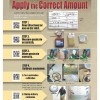 Pest managers must know the proper amount of pesticide product to apply. This poster acquaints new pest control technicians with the basic process of following label instructions to properly dilute pesticides, and it walks technicians through two types of basic equipment calibration. The poster has quick response (QR) codes that link smartphones to online videos illustrating each step in applying the correct amount of pesticides. Designed by R.W. Baldwin, S.K. Hill, Philip Koehler, W. Walker, and J.C. Medley, and published by the UF Department of Entomology and Nematology, August 2012.
Pest managers must know the proper amount of pesticide product to apply. This poster acquaints new pest control technicians with the basic process of following label instructions to properly dilute pesticides, and it walks technicians through two types of basic equipment calibration. The poster has quick response (QR) codes that link smartphones to online videos illustrating each step in applying the correct amount of pesticides. Designed by R.W. Baldwin, S.K. Hill, Philip Koehler, W. Walker, and J.C. Medley, and published by the UF Department of Entomology and Nematology, August 2012.
http://edis.ifas.ufl.edu/in959
Pesticide Safety Miniposter: Labels and Material Safety Data Sheets (MSDSs) (ENY918/IN958)
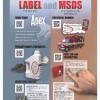 You have heard the phrase, “the label is the law.” Pest control technicians need to learn the components of a pesticide label and the information they can find on the Material Safety Data Sheet (MSDS). This poster acquaints new pest control technicians with the information they will find on pesticide labels and on MSDSs. The poster has quick response (QR) codes that direct smartphones to short, online videos explaining how to read pesticide labels and MSDSs. Designed by R.W. Baldwin, S.K. Hill, Philip Koehler, P.A. Mitola, and J.C. Medley, and published by the UF Department of Entomology and Nematology, August 2012.
You have heard the phrase, “the label is the law.” Pest control technicians need to learn the components of a pesticide label and the information they can find on the Material Safety Data Sheet (MSDS). This poster acquaints new pest control technicians with the information they will find on pesticide labels and on MSDSs. The poster has quick response (QR) codes that direct smartphones to short, online videos explaining how to read pesticide labels and MSDSs. Designed by R.W. Baldwin, S.K. Hill, Philip Koehler, P.A. Mitola, and J.C. Medley, and published by the UF Department of Entomology and Nematology, August 2012.
http://edis.ifas.ufl.edu/in958
Pesticide Safety Miniposter: Daily Personal Care (ENY917/IN956)
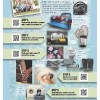 Anyone applying pesticides should be aware of the importance of preventing pesticide exposure to themselves, their families, and their pets by following a few personal care procedures each day. The information and video links (QR codes) on the Daily Personal Care poster provide technicians with examples of areas that are commonly contaminated by pesticides. The poster explains methods for the decontamination of vehicles, application equipment, personal items like cell phones, and clothing. Designed by R.W. Baldwin, S.K. Hill, Philip Koehler, W. Walker, and J.C. Medley, and published by the UF Department of Entomology and Nematology, August 2012.
Anyone applying pesticides should be aware of the importance of preventing pesticide exposure to themselves, their families, and their pets by following a few personal care procedures each day. The information and video links (QR codes) on the Daily Personal Care poster provide technicians with examples of areas that are commonly contaminated by pesticides. The poster explains methods for the decontamination of vehicles, application equipment, personal items like cell phones, and clothing. Designed by R.W. Baldwin, S.K. Hill, Philip Koehler, W. Walker, and J.C. Medley, and published by the UF Department of Entomology and Nematology, August 2012.
http://edis.ifas.ufl.edu/in956
Pesticide Safety Miniposter: Pesticide Formulations (ENY915/IN955)
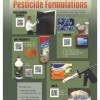 Do you need a quick training reference to common pesticide formulations? This poster introduces new pest control technicians to pesticide product formulations. The poster has quick response (QR) codes that link to videos showing example formulations of liquid pesticides, baits, pressurized aerosols, and a variety of dry product pesticides. Technicians need to be familiar with the products and formulations they are using, so this poster and its videos will be a useful training tool for pest management companies. Designed by R.W. Baldwin, S.K. Hill, Philip Koehler, P.A. Mitola, and J.C. Medley, and published by the UF Department of Entomology and Nematology, August 2012.
Do you need a quick training reference to common pesticide formulations? This poster introduces new pest control technicians to pesticide product formulations. The poster has quick response (QR) codes that link to videos showing example formulations of liquid pesticides, baits, pressurized aerosols, and a variety of dry product pesticides. Technicians need to be familiar with the products and formulations they are using, so this poster and its videos will be a useful training tool for pest management companies. Designed by R.W. Baldwin, S.K. Hill, Philip Koehler, P.A. Mitola, and J.C. Medley, and published by the UF Department of Entomology and Nematology, August 2012.
http://edis.ifas.ufl.edu/in955
Self-Treatment Methods for Livestock–Backrubbers (ENY279/IG134)
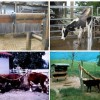 Back rubbers are a method of pesticide self-treatment for cattle. When bothered by insects or other pests, cattle tend to rub against objects. Backrubbers provide a rubbing surface that is treated with a pesticide. Cattle self-treat during rubbing, which reduces the number of flies, particularly horn flies, and parasites such as lice, on the animal. Backrubbers may be purchased commercially or constructed from easily available materials. A properly designed backrubber that supplies pesticide reliably to the animal can be a valuable addition to an integrated pest management program. This 4-page fact sheet was written by E. N. I. Weeks and P. E. Kaufman, and published by the UF Department of Entomology and Nematology, September 2012.
Back rubbers are a method of pesticide self-treatment for cattle. When bothered by insects or other pests, cattle tend to rub against objects. Backrubbers provide a rubbing surface that is treated with a pesticide. Cattle self-treat during rubbing, which reduces the number of flies, particularly horn flies, and parasites such as lice, on the animal. Backrubbers may be purchased commercially or constructed from easily available materials. A properly designed backrubber that supplies pesticide reliably to the animal can be a valuable addition to an integrated pest management program. This 4-page fact sheet was written by E. N. I. Weeks and P. E. Kaufman, and published by the UF Department of Entomology and Nematology, September 2012.
http://edis.ifas.ufl.edu/ig134
Carbon Sequestration in Grazing Land Ecosystems (SL373/SS574)
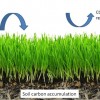 Native and improved pastures play an important role in sequestering carbon from the atmosphere. Because of the relatively high sequestration rates and extensive area, grazing land represents an important component of terrestrial carbon dioxide (CO2) offset and is a significant sink for long-term carbon sequestration and greenhouse gas mitigation. This 4-page fact sheet contains information for stakeholders, students, scientists, and environmental agencies interested in enhancing ecosystems services provided by grazing lands. Written by Maria Silveira, Ed Hanlon, Mariana Azenha, and Hiran M. da Silva, and published by the UF Department of Soil and Water Science, September 2012.
Native and improved pastures play an important role in sequestering carbon from the atmosphere. Because of the relatively high sequestration rates and extensive area, grazing land represents an important component of terrestrial carbon dioxide (CO2) offset and is a significant sink for long-term carbon sequestration and greenhouse gas mitigation. This 4-page fact sheet contains information for stakeholders, students, scientists, and environmental agencies interested in enhancing ecosystems services provided by grazing lands. Written by Maria Silveira, Ed Hanlon, Mariana Azenha, and Hiran M. da Silva, and published by the UF Department of Soil and Water Science, September 2012.
http://edis.ifas.ufl.edu/ss574
Pesticide Safety Miniposter: Pesticide Emergencies (ENY916/IN954)
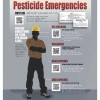 This poster introduces new pest control technicians to the general actions to be taken in the event of pesticide exposure. Technicians learn to recognize symptoms of exposure as they watch videos linked to the quick response (QR) codes on the poster. The videos detail general first aid steps to undertake until medical help arrives after a pesticide exposure. Designed by R.W. Baldwin, S.K. Hill, Philip Koehler, W. Walker, and J.C. Medley, and published by the UF Department of Entomology and Nematology, August 2012.
This poster introduces new pest control technicians to the general actions to be taken in the event of pesticide exposure. Technicians learn to recognize symptoms of exposure as they watch videos linked to the quick response (QR) codes on the poster. The videos detail general first aid steps to undertake until medical help arrives after a pesticide exposure. Designed by R.W. Baldwin, S.K. Hill, Philip Koehler, W. Walker, and J.C. Medley, and published by the UF Department of Entomology and Nematology, August 2012.
http://edis.ifas.ufl.edu/in954
Bottling, Labeling and Selling Honey in Florida (ENY159/IN918)
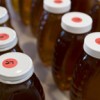 In 2011, the Florida Legislature enacted HB 7209 allowing individuals to manufacture, sell, and store certain types of “cottage foods”(including honey) in an unlicensed kitchen. “Cottage food operations,” as they are called, require no licensing or permitting from the Florida Department of Agriculture and Consumer Services and are not inspected by any other state government entity. This 4-page fact sheet was written by Nancy Gentry and James D. Ellis, and published by the UF Department of Entomology and Nematology, August 2012.
In 2011, the Florida Legislature enacted HB 7209 allowing individuals to manufacture, sell, and store certain types of “cottage foods”(including honey) in an unlicensed kitchen. “Cottage food operations,” as they are called, require no licensing or permitting from the Florida Department of Agriculture and Consumer Services and are not inspected by any other state government entity. This 4-page fact sheet was written by Nancy Gentry and James D. Ellis, and published by the UF Department of Entomology and Nematology, August 2012.
http://edis.ifas.ufl.edu/in918
Florida Bears and Beekeeping (ENY105/AA133)
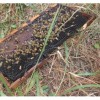 The Florida black bear (Ursus americanus floridanus) is a minor predator of beehives in Florida with the potential to cause major destruction. Large-scale urban and agricultural development inexorably reduces prime bear habitat each year. This habitat also contains excellent bee forage, and so bears and bees will sometimes come in contact, thus resulting in bear predation. This 4-page fact sheet was written by Malcolm T. Sanford and James D. Ellis, and published by the UF Department of Entomology and Nematology, August 2012.
The Florida black bear (Ursus americanus floridanus) is a minor predator of beehives in Florida with the potential to cause major destruction. Large-scale urban and agricultural development inexorably reduces prime bear habitat each year. This habitat also contains excellent bee forage, and so bears and bees will sometimes come in contact, thus resulting in bear predation. This 4-page fact sheet was written by Malcolm T. Sanford and James D. Ellis, and published by the UF Department of Entomology and Nematology, August 2012.
http://edis.ifas.ufl.edu/aa133
Developing Land in Florida with Fire in Mind: Recommendations for Designers, Developers, and Decision Makers (FOR63/FR059)
 In 1998, fire destroyed or damaged 330 homes and businesses in Florida. Losses totaled more than $800 million. In some places, homes were saved by fire-fighting crews, or where the right decisions were made by builders or designers. With advance planning, architects and developers can do a great deal to reduce wildfire risk for those living and working in Florida. This 5-page fact sheet was written by Martha C. Monroe and Susan Marynowski, and published by the UF Department of School of Forest Resources and Conservation, September 2012.
In 1998, fire destroyed or damaged 330 homes and businesses in Florida. Losses totaled more than $800 million. In some places, homes were saved by fire-fighting crews, or where the right decisions were made by builders or designers. With advance planning, architects and developers can do a great deal to reduce wildfire risk for those living and working in Florida. This 5-page fact sheet was written by Martha C. Monroe and Susan Marynowski, and published by the UF Department of School of Forest Resources and Conservation, September 2012.
http://edis.ifas.ufl.edu/fr059
Landscaping in Florida with Fire in Mind (FOR71/FR076)
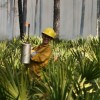 Fire is a powerful part of Florida’s landscape. It can maintain healthy natural ecosystems (Figure 1), but can also turn a home to ashes. Florida’s frequent lightning strikes and human carelessness guarantee that wildfire will continue to be a factor in both rural and suburban areas. Some homeowners may wonder if they are in danger of wildfire. Find out if you are at risk, and follow these guidelines to reduce the threat of wildfire. This 4-page fact sheet was written by Martha Monroe, Alan Long, and published by the UF Department of School of Forest Resources and Conservation, September 2012.
Fire is a powerful part of Florida’s landscape. It can maintain healthy natural ecosystems (Figure 1), but can also turn a home to ashes. Florida’s frequent lightning strikes and human carelessness guarantee that wildfire will continue to be a factor in both rural and suburban areas. Some homeowners may wonder if they are in danger of wildfire. Find out if you are at risk, and follow these guidelines to reduce the threat of wildfire. This 4-page fact sheet was written by Martha Monroe, Alan Long, and published by the UF Department of School of Forest Resources and Conservation, September 2012.
http://edis.ifas.ufl.edu/fr076
How to Report Pesticide Misuse in Florida (PI241)
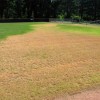 Pesticides provide benefits in many facets of daily life, including protecting food production and health, enhancing our recreational areas, maintaining our rights-of-way, and protecting wildlife, aquatic sites, and natural areas. However, misuse does occur and those who are negligent must take responsibility for their actions. This 3-page fact sheet was written by F. M. Fishel, and published by the UF Department of Agronomy, October 2012.
Pesticides provide benefits in many facets of daily life, including protecting food production and health, enhancing our recreational areas, maintaining our rights-of-way, and protecting wildlife, aquatic sites, and natural areas. However, misuse does occur and those who are negligent must take responsibility for their actions. This 3-page fact sheet was written by F. M. Fishel, and published by the UF Department of Agronomy, October 2012.
http://edis.ifas.ufl.edu/pi241
Effects of Climate Change on the Eutrophication of Lakes and Estuaries (SGEF189/SG127)
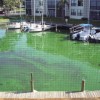 Recent research suggests that climate change will reinforce the negative consequences of man-made eutrophication and make it more difficult to improve water quality in lakes and estuaries.This 3-page fact sheet was written by Karl Havens, and published by the UF Department of Sea Grant, September 2012.
Recent research suggests that climate change will reinforce the negative consequences of man-made eutrophication and make it more difficult to improve water quality in lakes and estuaries.This 3-page fact sheet was written by Karl Havens, and published by the UF Department of Sea Grant, September 2012.
http://edis.ifas.ufl.edu/sg127
Forest Management in the Interface: Reducing Fire Risk (FOR179/FR249)
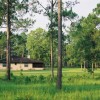 Wildfire is one of the most serious and publicized challenges facing interface forest management. Wildfires can change forest vegetation, affect human health, and cause millions of dollars’ worth of damage to homes, businesses, timber, and tourism. This 5-page fact sheet outlines tips for the firewise community development, design of structures, landscaping and fuel reduction. Written by Bruce Hull, Sarah F. Ashton, Rien M. Visser, and Martha C. Monroe, and published by the UF Department of School of Forest Resources and Conservation, August 2012.
Wildfire is one of the most serious and publicized challenges facing interface forest management. Wildfires can change forest vegetation, affect human health, and cause millions of dollars’ worth of damage to homes, businesses, timber, and tourism. This 5-page fact sheet outlines tips for the firewise community development, design of structures, landscaping and fuel reduction. Written by Bruce Hull, Sarah F. Ashton, Rien M. Visser, and Martha C. Monroe, and published by the UF Department of School of Forest Resources and Conservation, August 2012.
http://edis.ifas.ufl.edu/fr249
The Costs of Managing an Urban Forest (FOR217/FR279)
 Urban forests provide benefits to society often referred to as ecosystem services: they improve human health, environmental quality, and local economies by increasing property values and aesthetics in communities. They help cities control storm water, reduce air pollution and energy costs, and offset carbon dioxide emissions. But urban forests also have “ecosystem disservices.” An accurate assessment of an urban forest’s costs can assist decision makers to better understand the role the forest plays in improving the well-being of the community. Identifying how funding is used can also help communities minimize costs and increase benefits. This 4-page fact sheet will review some of the types of costs associated with urban forests and present typical financial costs associated with urban forest management in the city of Gainesville, Florida. Written by Francisco Escobedo and Jennifer Seitz, and published by the UF Department of School of Forest Resources and Conservation, October 2012.
Urban forests provide benefits to society often referred to as ecosystem services: they improve human health, environmental quality, and local economies by increasing property values and aesthetics in communities. They help cities control storm water, reduce air pollution and energy costs, and offset carbon dioxide emissions. But urban forests also have “ecosystem disservices.” An accurate assessment of an urban forest’s costs can assist decision makers to better understand the role the forest plays in improving the well-being of the community. Identifying how funding is used can also help communities minimize costs and increase benefits. This 4-page fact sheet will review some of the types of costs associated with urban forests and present typical financial costs associated with urban forest management in the city of Gainesville, Florida. Written by Francisco Escobedo and Jennifer Seitz, and published by the UF Department of School of Forest Resources and Conservation, October 2012.
http://edis.ifas.ufl.edu/fr279